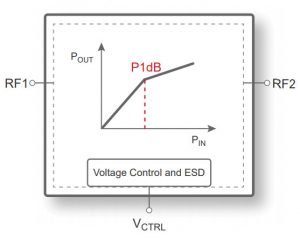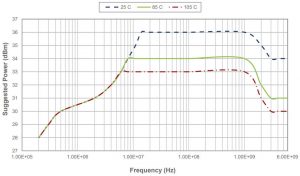[ad_1]
Pulsed in this case is 1% duty cycle – 10µs pulses in 1ms – in a 50Ω system at 25°C.
CW power handling varies around 33-36dBm from ~10MHz to 1GHz, depending on temperature (see graph).
“PE45361 delivers reliable and repeatable power protection to sensitive low-noise receivers for test-and-measurement equipment and wireless-infrastructure transceivers,” said Richardson RFPD, which is stocking the part, and offers design support. “Unlike traditional PIN diode solutions, PE45361 achieves an adjustable input 1 dB compression point or limiting threshold via a low current control voltage, eliminating the need for external bias components such as DC blocking capacitors, RF choke inductors and bias resistors.”
Power Limiting Mode
It performs as a linear power limiter with adjustable P1dB/limiting threshold, with the threshold adjusted by changing the control voltage between 0V and +0.3V. If unbiased, or set to 0V, it still offers power limiting protection.
Power Reflecting Mode
Power reflecting mode requires a power detector to sample the RF input power and a microcontroller to toggle the limiter control voltage between +3.0V and 0V based on the system protection requirements. At 3.0V, the limiter impedance to ground is less than 1Ω and most of the incident power will be reflected back to the source. At 0V, the device operates as in power limiting mode.
Typical insertion loss is 0.4dB 10MHz to 3GHz and 0.95dB 3-6GHz.
- Adjustable low power limiting threshold: from +7dBm to +13dBm
- Maximum handling: +50dBm (100W) pulsed
- Positive threshold control: from 0V to +0.3V
- <1ns response time
- 12 lead 3 x 3 x 0.5mm QFN
The chip is made on Peregrine’s silicon-on-insulator ‘UltraCMOS’ process.
[ad_2]
Source link


